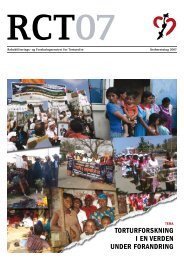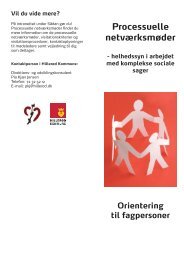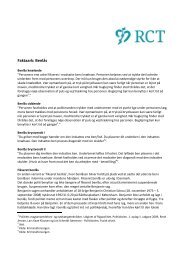Rehabilitating Torture Survivors - Dignity - Danish Institute Against ...
Rehabilitating Torture Survivors - Dignity - Danish Institute Against ...
Rehabilitating Torture Survivors - Dignity - Danish Institute Against ...
You also want an ePaper? Increase the reach of your titles
YUMPU automatically turns print PDFs into web optimized ePapers that Google loves.
WORKSHOP 1: Controversies in Assessment(Wednesday Dec 3 Afternoon)Controversies in Assessment – Chronic PainInvited lecturerUwe Harlacher, PhD, Chief PsychologistRehabilitation and Research Centre for <strong>Torture</strong> <strong>Survivors</strong>,Copenhagen, DenmarkThe assessment and measurement of pain implies manifold problems and controversies.Instead of focusing on technical aspects of pain-measurement suchas suitability of various measurement-instruments and scales, some more generaland principle controversies and problems will be discussed. These controversiesand problems arise because pain is a complex phenomenon, interactingwith other variables.The presented controversies and problems are:a) Pain might rather be secondary or subordinated to other problems than acentral problem per se. Examples of this will be presented and discussed.b) Unsuitable measurement of physical performance: the standardized measurementof physical performance, e.g. pre and post treatment might give misleadingresults if not embedded in a wider context of everyday activities.c) Too narrow focus on pain: a maximum reduction of pain is not a given centralgoal of treatment.d) Ignoring of long-term-perspective: short term strategies for coping with painmight not be suitable in the long run.e) Ignoring of subgroups: the population of pain-patients is not homogenouswith respect for e.g. general activity, some are (too) active, other (too) lowactivewith consequences on suitable treatment goals and interpretation oftreatment-results.f) Activity shift within individuals/pacing: This relatively complex phenomenonis described as important for some cases but at the same time as difficult toassess and measure.The treatment-philosophy of ”Acceptance and Commitment Therapy”(respectively a short and pronounced sharp formulation of that philosophy)is discussed in connection with points c), d) and f). It is argued that, dependingon subgroup and other variables that characterize the pain-problem,the utility of this philosophy can vary greatly from highly applicable (point c) tocounterproductive (points d) and f)).ReferencesTurck DC, WinterF. The pain survival guide, how to reclaim your life. WashingtonDC: American Psychological Association, 2006.Mc Cracken LM. Contextual cognitive-behavioral therapy for chronic pain. IASPpress, 2005.Butler D, Mosley L. Explain pain. Noigroup Publications, 2003.13






